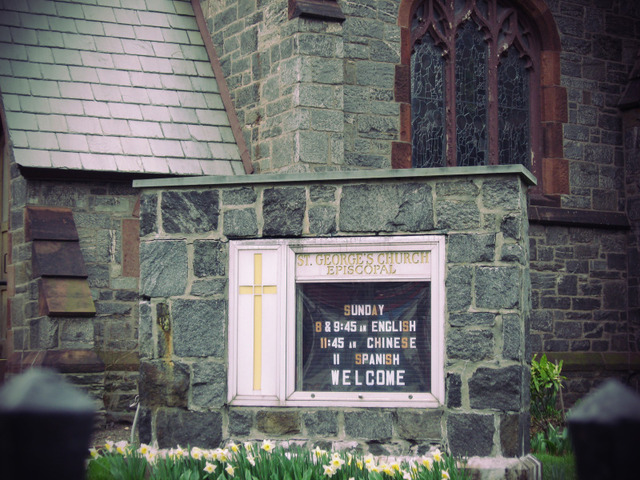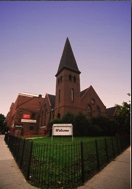From The Peopling of New York City
The religious institutions of Flushing reflect the diversity of people that live there. From Buddhist temples to Mosques and Christian churches, any resident of Flushing can find his own religious sanctuary. Many of the churches try as best as they can to accommodate the different immigrant populations with multilingual services and congregations.
Contents |
St. George's Episcopal Church
History
The St. George parish, also known as the St. George Episcopal Church, was chartered by King George the Third, ten years before the war for independence. Founded in 1802 by Father George Keith, an ex-Quaker Anglican missionary from the Society for the Propagation of the Gospel in Foreign Parts, from the Church of England. The Church of England was worried about the "nefarious" influence of Quakers on colonists and was thus interested in sending Anglican missionaries to the colonies. Father Keith founded five parishes in Long Island area, three within the current city limits. This church was the principle seat, located in a flourishing town. This church was influential in the formation of the Episcopal Church in the United States, breaking away from the Church of England. Originally the Church's congregation constituted of English people; however, since this church was the only alternative to the Quaker church in the neighborhood, people who were not Anglicans would come to the mass and the church took them in.
With the various waves of immigration coming into New York, the church, willingly and sometimes unwillingly, took in more and more diverse congregations. It began welcoming Dutch and Germans and then, as immigration changed, Eastern Europeans such as Italians and Irish. Yet neither of those groups would become the majority of the church’s future community.
Chinese Immigrants
Starting in the 1950's, Latino immigration to Flushing increased, followed by a heavy Chinese immigration. Many of Chinese coming in to the neighborhood were already Anglicans. Along with the Chinese also came Indian Anglicans. Thus the St. George Episcopal Church in Flushing attracted many of these immigrants. At first, many of the Chinese and Indians that came were English-speaking immigrants, but as immigration to the area increased and changed, more Chinese coming in were not English speaking. The original and older Asian congregation at St. George’s was mainly from Hong Kong, and was composed of primarily Cantonese speakers. In the 1980's, missionaries Father Kwan and Father Shay were hired to get the church more involved in the community and this resulted in newer immigrants joining the church. At this time the immigration from China began to shift from Hong Kong, Cantonese speakers to Mandarin speakers from all parts of China. The church's Chinese congregation has grown exponentially in the past ten years, and most of the new members have been Mandarin-speaking Chinese immigrants. Nowadays the congregation of the Chinese mass is double that of the English and Latino masses combined.
Latino Immigrants
In the 1980's, the Church got involved with the local Latino community. Spanish speaking locals and non-locals would stop by and ask about a Spanish mass, which did not exist at the time. The Church decided to hire a Spanish speaking priest to hold a Sunday evening mass. The Latino community at the church grew and soon requested a midweek mass as well. Father Chase was hired part-time to help out with the growing demand. Currently the church holds three masses in Spanish throughout the week. Through the years the Spanish congregation has fluctuated but in the past five years the Sunday mass attendance has doubled.
Celebrations
The Church hosts many celebrations and events that highlight and celebrate the diverse cultures that surround it. Asian holidays, especially the Lunar New Year, are especially popular with the Church. In addition to ethnic holidays, the church holds immigrant celebrations of American holidays, such as Thanksgiving. Chinese and Latino immigrants, especially, flock to the Church for these major celebrations because they do not have a family tradition of celebrating these holidays. The church also supports cultural religious celebrations, especially Latino Catholic holiday traditions, which shows that St. George's represents not only diverse peoples, but also diverse traditions.
Now and the Church’s Leadership
Currently the majority of the church's community is composed of Asians. At the Church's Annual Parish Meeting, during which the governing body of the church is elected, Chinese, mainly Mandarin speakers, compromised 85% of the attendees. Latinos and other English speaking groups, such as immigrants from the West Indies, Africa, India, Malaysia and South Africa, were in the other 15%.
The Church's governing body, the vestry, is composed of six people. Every year during the Parish meeting, two of the officials are replaced by elections. The first Chinese was elected to the vestry was about twenty five years ago and the first Latino was elected twelve years ago. Formerly, the vestry was composed of two Anglos, two Chinese and two Latinos. After this year's elections, however, there are now three Chinese, one Latino and one Anglo official. The Church expects two more Chinese to be elected next year, and in the future to be entirely Chinese. The Church is worried about the disappearance of Anglo and Latino leadership, who represent immigrants as well, though from a wide variety of places such as the West Indies, Africa, India, Malaysia and South Africa, but acknowledges that the growth of Chinese leadership is inevitable because of the high influx of Chinese parishioners. The church's other officials, its two wardens, also represent the diverse spirit of the church. One is Chinese who is fluent in Fuzhounese, Mandarin, Filipino and English, and the other is a Latino, who also speaks fluently in English and Spanish.
First Baptist Church of Flushing
Intro
The following information comes from an interview given by Iris Holder, who has attended the church since the mid 1940's and has worked in a variety of positions at the church throughout the years. When Mrs. Holder joined the church, it had been predominantly white, and Mrs. Holder, being an African American, was one of the first few to integrate the church.History
The First Baptist Church of Flushing was founded by Howard Osgood in 1857. The church has, through out all of its history, been associated with helping and accepting immigrants. Within just the first few decades of its opening, the church was deeply committed to helping Irish immigrants that were hurt by the potato famine.
Congregations and Diversity
The First Baptist Church of Flushing, besides having a rich history, boasts an amazingly diverse membership. The church is essentially an immigrant church.
The Church consists of three different congregations: Chinese, Hispanic and English congregation. The English congregation is only called English for the language that loosely unites the members. Most attendants of this congregation are immigrants from every part of the world who range from new to fluent speakers of the English language. It is this congregation that can be called the multicultural start and roots of the church. India, Pakistan, Indonesia, Philippines, Vietnam, Burma, West Indies, Africa and Europe are just a few of the native regions from which members hail from. Chinese members are present, but only because they are either more fluent in English than Mandarin, which is the language of the Chinese congregation, or they have been born in America and do not speak their parent's native tongue at all. There are also Chinese immigrants that attend the English congregation who have been previously immigrants of another country before coming to the United States. Native Chinese immigrants from Burma, Brazil, Columbia, Venezuela and Jamaica can be found in the crowd.
Most of the people in the Chinese Congregation were originally from Hong Kong, Cantonese speaking, yet now the immigration has shifted to the mainland China and this has been accompanied by a shift from Cantonese to Mandarin. The congregation started out as Chinese group that rented space for religious services. They were invited to join the First Baptist Church of Flushing in the late 1970's and the group, when they accepted, became the foundation for the Chinese congregation that exists today.
The Hispanic congregation consists of people from all over South and Central America, with most countries represented in the congregation. The Hispanic congregation was founded in the 1980's.
Out of the three congregations, the English-speaking congregation, with approximately 450 members, is the largest. The Chinese congregation, however, is growing and, at around 200 members, is the second largest. The Hispanic congregation consists of about 150 members and experiences a large turnover of members as immigrants move out of New York City.
The Church does its best to celebrate and accommodate the cultural religious holidays of the nationalities that attend it. Most of the ethnic celebrations that take place are organized and celebrated by the Chinese and Hispanic congregations, but not the English congregation. This is because the population of the English is so diverse and every nationality in it celebrates the holidays somewhat differently, all groups have to come together to celebrate the American holidays. The church does hold annual international feast that encourages everyone to dress up in their national costumes.
References
- St George's Episcopal Church: Father Chase (Pastor at St. George) interviewed by Albina Khayrulina April 10th, 2010.
- First Baptist Church of Flushing: Iris Holder (Church Staff, Mentor, Member) interviewed by Albina Khayrulina, April 29th 2010

